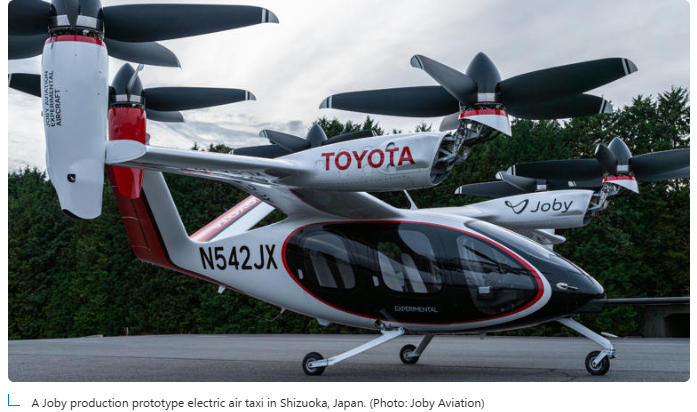|
Getting your Trinity Audio player ready...
|
Introduction
In a groundbreaking development for the future of transportation, Toyota and Joby Aviation have unveiled their electric air taxi at the Higashi-Fuji Technical Center in Shizuoka, Japan. The new electric vertical takeoff and landing (eVTOL) aircraft is a significant step toward revolutionizing urban mobility with zero emissions, high-speed travel, and reduced noise pollution. The unveiling comes just weeks after Toyota committed an additional $500 million to support Joby Aviation’s efforts to certify and commercialize its innovative electric air taxi, which is poised to transform urban air mobility (UAM).
This partnership signals a major leap in sustainable transportation technologies and could reshape the future of air travel, offering a cleaner and quieter alternative to traditional helicopters and planes.
1. The Electric Air Taxi: Design and Features
The electric air taxi unveiled by Toyota and Joby is designed to accommodate a pilot and four passengers, offering high-speed, short-distance travel. With a top speed of 200 mph (320 km/h), the eVTOL promises a fast, efficient, and eco-friendly mode of transportation, especially suitable for urban areas where congestion is a growing issue.
Some key features of the air taxi include:
- Electric Propulsion: The air taxi is fully electric, offering a zero-emissions alternative to traditional fossil-fuel-powered aviation. This aligns with global efforts to reduce carbon footprints and combat climate change.
- Vertical Takeoff and Landing (VTOL): The aircraft’s VTOL capabilities enable it to take off and land vertically, making it ideal for crowded urban environments and areas with limited space for traditional airports.
- Noise Reduction: One of the key advantages of the eVTOL is its significantly lower noise levels compared to conventional helicopters, making it more suitable for densely populated areas.
- Capacity: Designed to carry one pilot and four passengers, the air taxi aims to provide efficient travel for small groups, similar to the capacity of a small private jet or helicopter.
2. Toyota’s $500 Million Investment in Joby Aviation
The announcement of the electric air taxi comes just weeks after Toyota increased its investment in Joby Aviation by an additional $500 million, raising its total investment to more than $700 million. The funds will support Joby Aviation’s efforts to gain certification from aviation regulators and prepare for the commercial rollout of its electric air taxis.
Toyota’s investment is a strategic move in the company’s efforts to position itself at the forefront of future mobility technologies. The partnership with Joby Aviation strengthens Toyota’s commitment to sustainability, offering a promising alternative to carbon-heavy modes of travel. The collaboration leverages Toyota’s expertise in manufacturing and electric vehicle technologies alongside Joby’s innovations in electric flight.
The partnership also highlights Toyota’s increasing involvement in the urban air mobility (UAM) space, which is rapidly gaining attention as an innovative solution to traffic congestion and environmental concerns in metropolitan areas.
3. A Sustainable Alternative to Traditional Aviation
The electric air taxi offers numerous advantages over traditional helicopters and small aircraft, particularly in terms of environmental impact and noise levels.
a. Zero Emissions
One of the most compelling features of the air taxi is its zero-emissions operation. As governments and cities around the world strive to meet climate goals and reduce the impact of transportation on air quality, the widespread adoption of electric air taxis could significantly reduce emissions from the aviation sector, which is responsible for a considerable share of global carbon emissions.
b. Reduced Noise Pollution
Unlike traditional helicopters, which can be loud and disruptive in urban environments, the electric air taxi is designed to operate with substantially lower noise levels. This makes it a more community-friendly option for urban air mobility, particularly in densely populated cities where noise pollution is a significant concern.
c. Energy Efficiency
Electric propulsion systems are more energy-efficient than their internal combustion counterparts, meaning the electric air taxi could operate with lower energy consumption per mile flown. With the use of renewable energy to charge the aircraft, this mode of transport could be nearly carbon-neutral, further enhancing its appeal as an environmentally responsible alternative.
4. The Future of Urban Air Mobility (UAM)
Urban air mobility is gaining momentum as a solution to some of the most pressing challenges facing cities, such as traffic congestion, pollution, and the need for faster transport. The introduction of electric air taxis represents a significant step in the development of this sector.
a. Reducing Congestion
As cities around the world continue to grow, traffic congestion is becoming a more acute problem. Air taxis could help alleviate this by providing a fast and efficient means of transport above ground-level traffic, potentially transforming the way people commute in urban areas.
b. Accessibility and Urban Integration
While electric air taxis may initially be aimed at premium markets due to their higher cost, the long-term vision is for them to become a more mainstream form of urban transport, integrated into city infrastructure with a network of vertiports for takeoff and landing. With regulatory approval and advancements in battery technology and air traffic management, the cost of air taxis could decrease over time, making them more accessible to a wider range of people.
c. Safety and Regulation
As with any new form of transportation, the safety and regulation of electric air taxis are key considerations. The certification process for electric aircraft is rigorous, requiring compliance with strict aviation standards. However, Joby Aviation’s collaboration with Toyota, which brings significant manufacturing expertise, could expedite the process of scaling up production while ensuring high safety standards.
5. Challenges and Considerations
Despite the promising potential of electric air taxis, there are several challenges to overcome:
a. Infrastructure Development
For electric air taxis to become a viable form of mass transportation, cities will need to develop the necessary infrastructure, including vertiports for takeoff and landing, charging stations, and integration into existing urban transport networks.
b. Battery Technology and Range
While the air taxi is designed for short-distance travel, the current limitations of battery technology may restrict the range and operational capabilities of these aircraft. Ongoing advancements in battery efficiency and energy storage will be crucial to the widespread adoption of eVTOLs.
c. Cost and Accessibility
The cost of developing and operating electric air taxis remains high, which may limit their initial accessibility to affluent passengers. However, as the technology matures and economies of scale are achieved, the cost could decrease, making this mode of transport more accessible to a broader population.
6. Conclusion: A Step Toward the Future of Mobility
The unveiling of the Toyota-Joby Aviation electric air taxi is a significant milestone in the race to transform urban transportation and combat environmental challenges. With its zero-emissions technology, quiet operation, and potential to revolutionize city commuting, the electric air taxi promises to change the way we think about travel in urban spaces.
Supported by Toyota’s $500 million investment, Joby Aviation is well-positioned to move forward with the certification and commercial rollout of this cutting-edge technology. As the world seeks cleaner, faster, and more efficient ways to navigate cities, electric air taxis could soon become a common sight in the skies above.
Sources:



